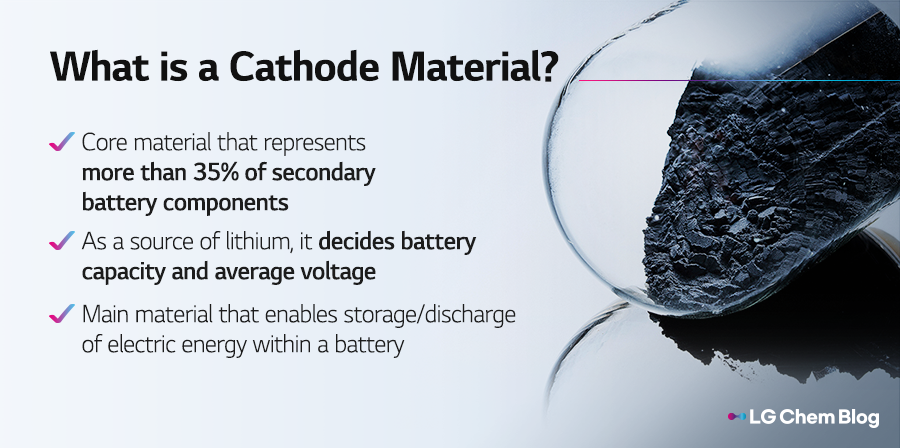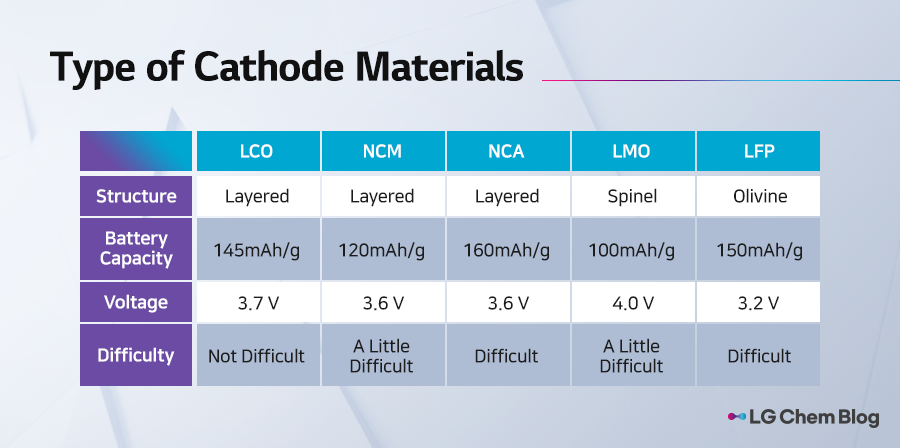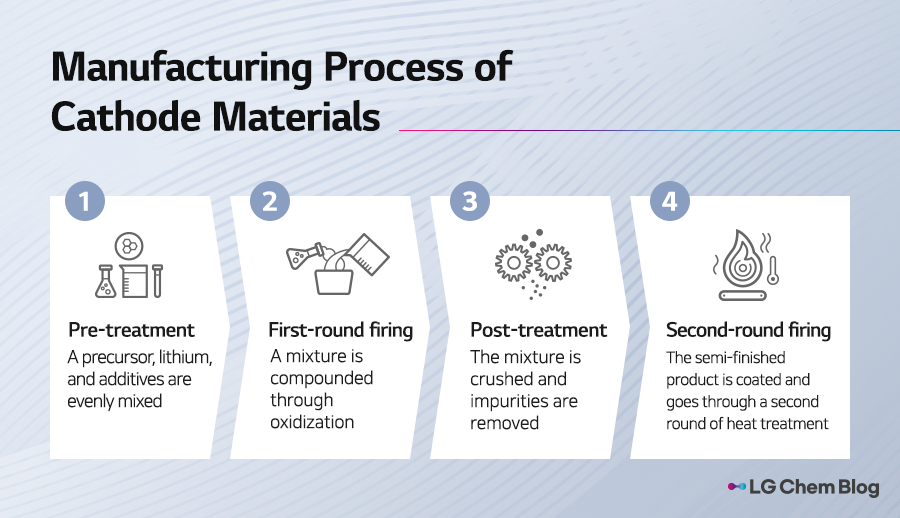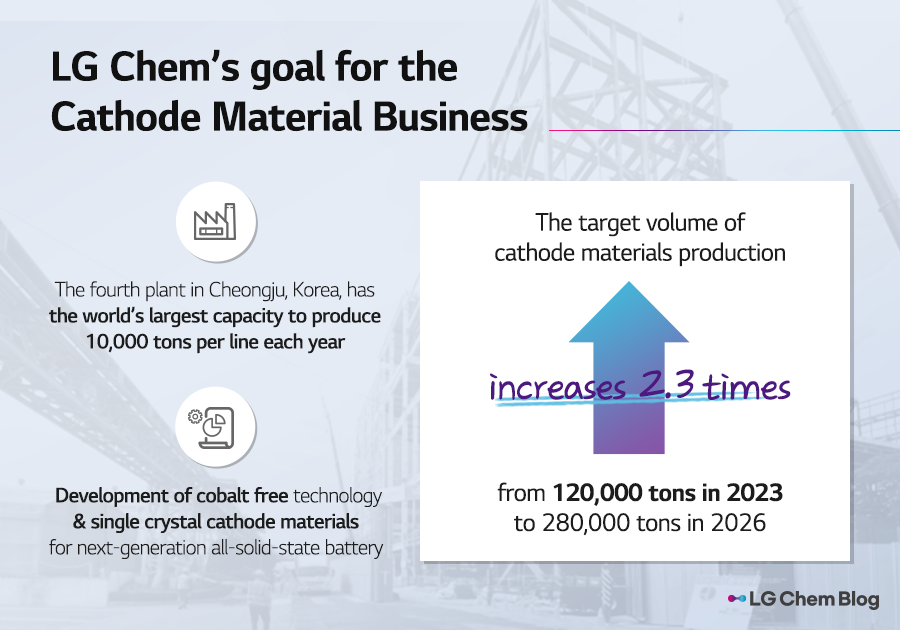LG Chem, a leader in the market for battery materials! Find out how the company built a plant to produce 120,000 tons of cathode materials each year
2023. 05. 04
2023. 05. 04
Cathode materials are a critical part of electric vehicle (EV) batteries, representing nearly 40% of battery production costs, and determining car performance in terms of travel distance, charge capacity, and discharge capacity. Last year, LG Chem built a facility to mass produce cathode materials, able to manufacture 120,000 tons per year. Learn more about LG Chem’s cathode materials.

A lithium-ion battery consists of cathode material, anode material, a separator, and electrolytes. Among these, cathode materials are a source of lithium-ions, with the type of active cathode material* determining the battery’s capacity and average voltage. To increase energy density, it is important to maximize the energy density of active cathode materials such as nickel, manganese, cobalt, and aluminum. Nickel has high capacity, manganese and cobalt improve stability, and aluminum enhances output. These materials are mixed at various ratios, and the two most widely used mixtures are NCM (Li, O, Ni, Co, Mn) and NCA (Li, Ni, Co, Al, O).
* Active cathode materials: Materials that involve in a battery’s electrode reaction at a cathode (e.g. lithium oxides)

The type of cathode materials affects a battery’s voltage, which is decided by a potential difference between a positive and a negative electrode. Cathode materials include LCO, NCM, NCA, LMO, and LFP depending on the composition of metal salt; by structure, they have three types: layered, spinel, and olivine.
A *layered structure enables to store a large number of lithium-ions between flat and wide layers. Ternary alloy including LCO, NCM, and NCA has a layered structure. LCO (Li, Co, O) is a basic form of cathode materials, and is widely used in small IT products including smartphones and laptops. LCO gives a long battery life, but is hardly used in car batteries because it has a lower energy density compared to NCM and NCA
NCM is a cathode material that added nickel and manganese to LCO. Cobalt in LCO is broken down and reconstructed with nickel, cobalt, and manganese. Recently, growing attention is given to NCM811(80% Ni, 10% Co, 10% Mn), which shows good energy efficiency due to the high content of Ni. NCA is a cathode material consisting of lithium, cobalt, aluminum, and oxygen. It has a high energy density, but due to its low level of safety, it is mostly used in small batteries.
LMO has a *spinel structure─a common structure for oxides─and less expensive by using manganese in place of cobalt. Its three-dimensional grid structure gives excellent stability. However, it has a small energy capacity and a short life. LFP has an *olivine structure whose hexahedral shape enhances stability. Performance deterioration due to charging/discharging is limited, and LFP resists heat very well. It is also economical as it uses iron instead of costly cobalt. However, compared to other cathode materials, LFP has a lower energy density, lower electric conductivity, and lower diffusion of lithium ions.
*Layered structure: The most straightforward structure of LiMO2 (M: Ni, Co, Mn)
*Spinel structure: Named after the stone spinel (MgAl2O4) also known as gahnite
*Olivine structure: A grid structure consisting of organically linked crystal hexahedrons

Manufacturing cathode materials goes through the stages of pre-treatment, first-round firing, post-treatment, and second-round firing. First, raw materials of *precursor and lithium are mixed with additives that are used to enhance safety. This mixture goes through a first round of firing in a kiln─temperature of 700~900℃─to synthesize with lithium oxide through oxidization.
This mixture goes through two rounds of crushing to produce powders of an optimal size called “crack,” and then goes through sifting and removal of iron to increase the purity of nickel. This is called a post-treatment. Then the semi-finished product is blended with a coating material for surface safety, and goes through a second round of firing at a temperature of 300~400℃. After another round of sifting, the final product is completed.
*Precursor: A material in the stage right before the final material A that is produced in a given chemical reaction. In a battery, a precursor indicates materials that make up cathode materials.

LG Chem’s fourth plant in Cheongju, Korea, is the world’s first facility with an annual production capacity of 10,000 tons of cathode materials per line. They started operation in the second half of 2022. The new production line is the same size as their competitors, but the hourly output volume is more than twice. The company will add two more lines to increase the annual output from the current 120,000 tons to 280,000 tons by 2026. Efforts are underway to develop cobalt free technology to reduce the use of cobalt which has high price volatility, and single crystal cathode materials for next-generation all-solid-state batteries.
LG Chem invested about $400 million (KRW 500 billion) in a cathode materials plant on a 60,000m2 site within the fifth national industrial complex in Gumi, Korea. The company plans to complete the construction within 2023 and start operation. The Gumi plant will have exclusive production lines for NCMA (Ni, Co, Mn, Al) used in next-generation EV batteries.
LG Chem signed an MOU to build a cathode materials plant in Tennessee, U.S., with 120,000 tons of annual output capacity. The construction will begin in 2023, and the plant will start operation in late 2025 to produce 120,000 tons of cathode materials annually by 2027.
The company’s target is to achieve a quadruple growth of the battery materials business by increasing revenues from about $3.8 billion (KRW 5 trillion) in 2022 to roughly $15.4 billion (KRW 20 trillion) by 2027. LG Chem is keep making bold investments in technology and facility to become a leading global company for EV battery materials.

There are no comments yet! Be the first to let us know your thoughts!